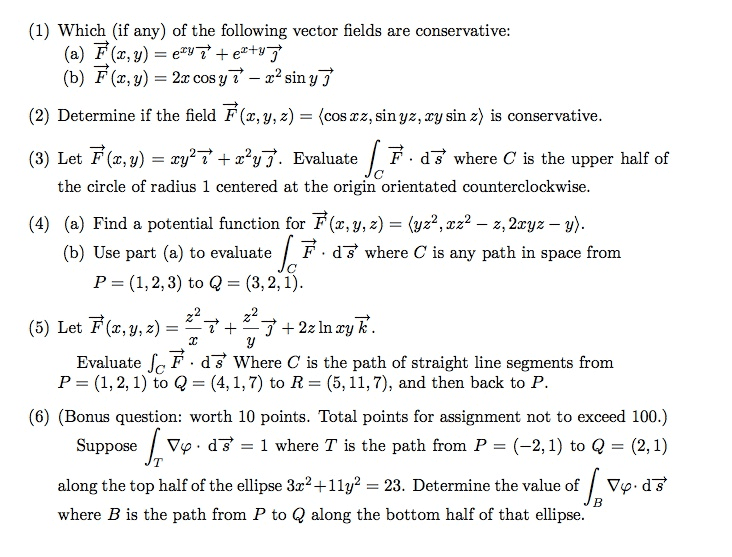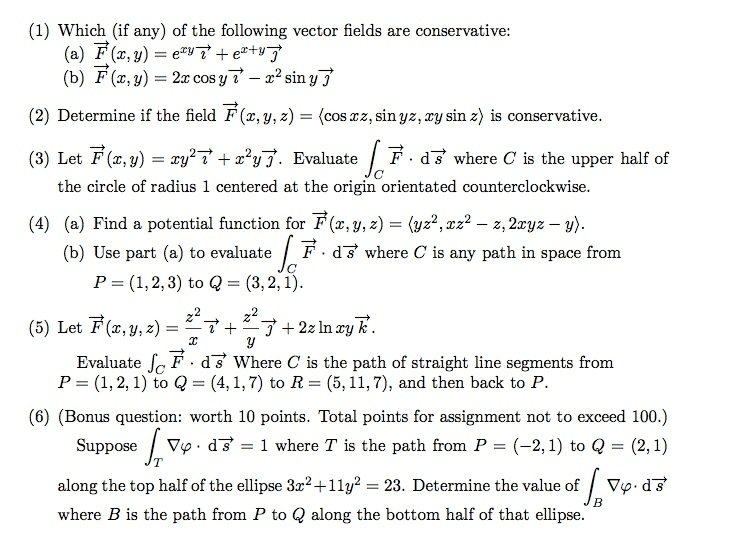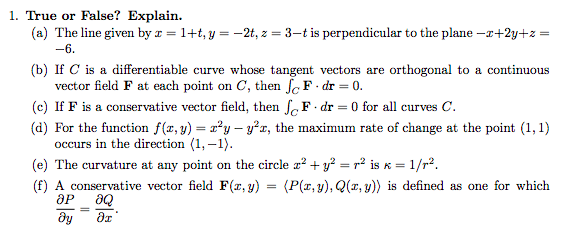1. (Curls) The curl of a vector field F = hP, Q, Ri is ? Ã F = i j k ?/?x ?/?y ?/?z P Q R = ?/?y ?/?z Q R i ? ?/?x ?/?z P R j + ?/?x ?/?y P Q k = ?R ?y ? ?Q ?z , ?P ?z ? ?R ?x , ?Q ?x ? ?P ?y . Suppose F = ?f, for a differentiable function of three variables whose first and second partials are all differentiable (everywhere). Show that ? Ã ?f = 0. Conclude that if F = hP, Q, Ri is conservative, then ? Ã F = 0.
2. (Details Matter) Let F = h?y, xi/(x 2 + y 2 ). Here we will show that F is not path independent, but it pass the conservative test. (a) What is the domain of F?
(b) Show that ?P ?y = ?Q ?x .
(c) Let C be the unit circle centered at the origin, oriented counter clockwise. Show that Z C F · dr 6= 0.
(d) Why does this not contradict what we discussed?
3. (Greenâs Theorem) The divergence of a vector field F = hP, Q, Ri is ? · F = ? ?x, ? ?y , ? ?z · hP, Q, Ri = ?P ?x + ?Q ?y + ?R ?z . In class, we discussed Greenâs Theorem which, under certain hypotheses, the formulas hold Z C F · T ds = Z Z R (? à F) · k dA Z C F · n ds = Z Z R ? · F dA, where T is the unit tangent vector and n is the outward pointing normal. Use the fact that Z C F · T ds = Z C P dx + Qdy Z C F · n ds = Z C P dy ? Qdx to solve the following line integrals in two different ways (as in interpretting it as work and flux separately).
(a) Z C (x 2 + 4y)dx + (x + y 2 )dy, where C is the square bounded by x = 0, x = 1, y = 0, and y = 1 (CounterClockWise).
(b) Z C (6x + y)dx + (y + 2x)dy, where C is the circle (x ? 2)2 + (y ? 3)2 = 4 (CCW). [Hint: You can avoid setting up bounds for the double integral in (b) by using geometry.]
1. (Curls) The curl of a vector field F = hP, Q, Ri is ? Ã F = i j k ?/?x ?/?y ?/?z P Q R = ?/?y ?/?z Q R i ? ?/?x ?/?z P R j + ?/?x ?/?y P Q k = ?R ?y ? ?Q ?z , ?P ?z ? ?R ?x , ?Q ?x ? ?P ?y . Suppose F = ?f, for a differentiable function of three variables whose first and second partials are all differentiable (everywhere). Show that ? Ã ?f = 0. Conclude that if F = hP, Q, Ri is conservative, then ? Ã F = 0.
2. (Details Matter) Let F = h?y, xi/(x 2 + y 2 ). Here we will show that F is not path independent, but it pass the conservative test. (a) What is the domain of F?
(b) Show that ?P ?y = ?Q ?x .
(c) Let C be the unit circle centered at the origin, oriented counter clockwise. Show that Z C F · dr 6= 0.
(d) Why does this not contradict what we discussed?
3. (Greenâs Theorem) The divergence of a vector field F = hP, Q, Ri is ? · F = ? ?x, ? ?y , ? ?z · hP, Q, Ri = ?P ?x + ?Q ?y + ?R ?z . In class, we discussed Greenâs Theorem which, under certain hypotheses, the formulas hold Z C F · T ds = Z Z R (? à F) · k dA Z C F · n ds = Z Z R ? · F dA, where T is the unit tangent vector and n is the outward pointing normal. Use the fact that Z C F · T ds = Z C P dx + Qdy Z C F · n ds = Z C P dy ? Qdx to solve the following line integrals in two different ways (as in interpretting it as work and flux separately).
(a) Z C (x 2 + 4y)dx + (x + y 2 )dy, where C is the square bounded by x = 0, x = 1, y = 0, and y = 1 (CounterClockWise).
(b) Z C (6x + y)dx + (y + 2x)dy, where C is the circle (x ? 2)2 + (y ? 3)2 = 4 (CCW). [Hint: You can avoid setting up bounds for the double integral in (b) by using geometry.]



